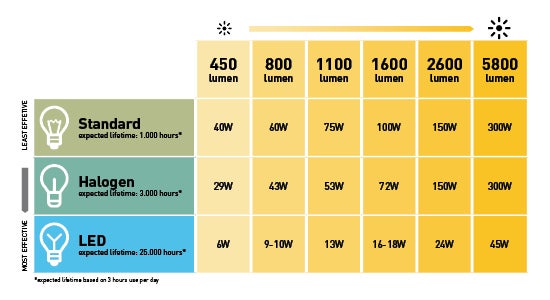What Work Lights Are Essential for Optimal Job Performance?
Working in low-light conditions necessitates precise lighting for safety, efficiency, and accident prevention. The ideal lighting requirements vary based on the specific job at hand.
Optimal Color Temperature: Enhancing Performance, Reducing Fatigue, and Ensuring Safety
The right colour temperature of lighting has a major influence on people's reaction and performance. Too weak or dull light causes you to get tired faster. Even lighting also ensures relaxed vision. In short: with the correct lighting, the chance of making mistakes is reduced and dangerous situations can be detected at an earlier stage. That is why it is extremely important to choose the correct lights.
Exploring Work Light Options: Halogen, Xenon and LED
When buying work lights, you should know that there are three main types of work lights. Below you will find more information about each type.
Halogen Work Lights
The design of the halogen work lights has been improved over the years. The challenge lay mainly in the fact that the bulb produces a lot of heat. It is only possible to dissipate this heat if the lamps are relatively deep. The lamps have a darker, warmer colour and are known for their shorter service life and high energy consumption.
Xenon Work Lights
Xenon technology has significantly improved the light output of work lights. The light is bright, but does not consume more power. On the contrary. It does take a while for the gas to warm up, so that the lamp does not give immediate full output of light. The higher costs and complexity are a disadvantage. However, the lamps do consume considerably less energy than halogen lamps when the ideal temperature is reached and they have a longer service life.
LED Work Lights
Compared to the halogen work light, the LED work light consumes relatively little power. LED technology is much more advanced than the two aforementioned technologies. LED lighting scores considerably better in terms of lifespan, efficiency and light output.
LED lighting has the future
In many aspects, LED lighting outperforms other lamp types. It combines impressive light output with extended lifespan, making it an increasingly ideal choice. Moreover, the upfront cost of LED lighting has significantly decreased. From a sustainability standpoint, LED lighting excels, as depicted below, illustrating its ability to produce more lumens per watt—essentially, more light with less energy.
Furthermore, LED lighting offers several other advantages:
- Enhanced energy efficiency.
- Minimal heat emission*.
- Aesthetic and eye-pleasing light color.
- Modern and stylish designs.
- Versatile shapes and options.
*However, it's worth noting that the minimal heat emission, while advantageous in most scenarios, may pose a challenge in certain situations, such as winter snow clearing. Fortunately, a solution exists in the form of special LED work lights with heated lenses.

Selecting the Perfect Work Light: Factors and Types to Consider
To select the appropriate work light, it's essential to define the area you intend to illuminate and gauge its size. This assessment guides your choice of light intensity and beam angle, tailoring the lighting solution to your specific needs. Each application demands its unique lighting approach, offering the flexibility to opt for either a far-reaching, focused beam (like an illuminator or spotlight) or a broad, intense ambient lighting (such as a wide beam or floodlight). For those seeking the best of both worlds—coverage both in width and distance—a combined floodlight provides an ideal solution.
Floodlight Work Lamps: Boosting Safety and Visibility
Floodlight work lamps are primarily employed to illuminate expansive outdoor spaces, enhancing safety and visibility, especially around tractors or vehicles. Higher power ratings (measured in watts, W) translate to greater luminosity. It's noteworthy that LED technology outperforms traditional incandescent lamps in terms of illumination. LED work lights, with an output of around 1600 lumens, are the prevailing choice. They typically cover a range of approximately 20 to 40 meters, casting a wide, even illumination.
Spotlight Work Lights: Precision Illumination for Critical Tasks
Require enhanced visibility, such as for timely field edge or hay bale detection? Enter spotlight work lights. These LED lights project a focused beam of light. Greater wattage equates to an extended reach, spanning from over 40 meters to an impressive 150 meters. Notably, this beam is narrowly concentrated, with a dispersion angle of approximately 12-15° to the left and right.
Combo Work Lights: Versatile Illumination for All-Around Visibility
The combo work light type employs an ingenious lens construction to cast a balanced illumination, both broad and distant. This design is perfect when you need excellent visibility for tasks that span near and far, like late-evening grass chopping.
In group work scenarios, such as during harvest seasons or construction projects, opting for work lights with lower lumens or specialized lens techniques can be prudent to avoid blinding colleagues. For such purposes, we offer a dedicated selection of construction lamps, including options from brands like Nordic and Kramp.
Key Considerations When Choosing Work Lights
- Assess Your Current Setup:
Evaluate your current technology and weigh its advantages and disadvantages. There might be a more suitable technology that aligns better with your requirements. - Gauge Light Intensity:
Survey your workspace to determine the necessary light intensity. Understanding the type of work light you need is essential for this step. - Waterproofing Considerations:
If you require lighting that can withstand high-pressure cleaning, look for an IP69K type approval. This certification guarantees that the work light is fully waterproof. - Addressing Electromagnetic Radiation:
LED lights with higher power levels can generate electromagnetic interference on radios. Ensure your work light is equipped with EMC interference mitigation, with varying levels of protection available. A simple solution involves using a choke, such as FC05T or FC13T, positioned as close to the radio as possible. Additionally, avoid connecting LED lighting and radios to the same power source. - Warranty Assessment:
Understanding your warranty coverage is vital. A substantial warranty period often reflects the work light's quality and reliability.
Legality of Light Bars: Where You Can and Can't Use Them
It's essential to know that light bars are typically intended for use exclusively on private property. Their usage on public roads is officially prohibited, as indicated on their packaging with the common label 'off-road use only'.
Questions?
Would you like to take a closer look at the different working lights? Check out our article: What Work Lights Are Essential for Optimal Job Performance?. Please contact one of our product specialists, find a Kramp dealer near you or contact us at knowledgecenter@kramp.com.

